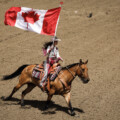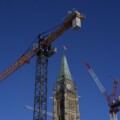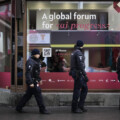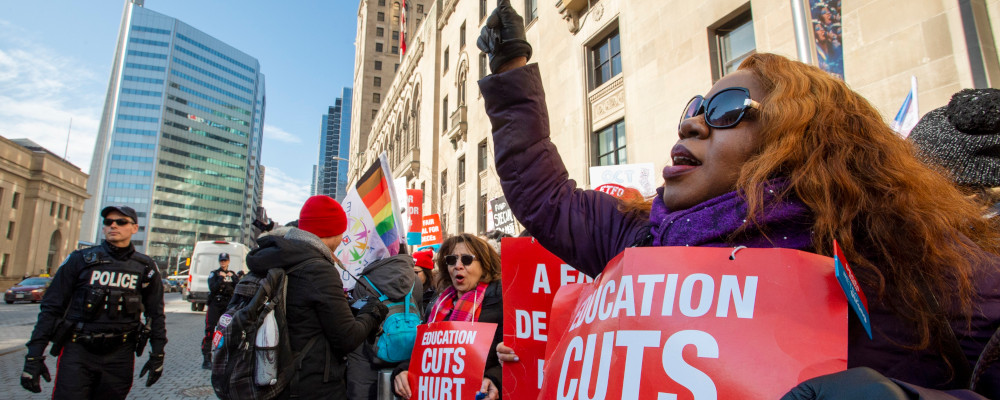Public education is an inherently controversial area of government policy as disputes over what should be taught are inevitable. Yet, what is interesting about the Ontario experience is that education controversies have tended to be as much about labour conflict as what gets taught in the classroom.
The province’s teachers and education workers unions are among the most militant in the country and, since the 1970s, their adversarial stance towards provincial governments has produced an enduring cyclical dynamic; otherwise routine efforts at education reform, changes to budgeting, or necessary contract renewals have produced predictable forms of organized resistance. Governments from all parties have in turn been accused of attacking public education, exploiting workers, and insulting the teaching profession.
While the basis of the dispute is often contingent on the nature of the government’s activity and the salient policy needs of the time, the root of the issue remains the same. This is a perennial conflict over the control over education that is aggravated by a series of enduring administrative and fiscal challenges. While ongoing concerns of fiscal sustainability continue to necessitate reform, initiatives from all three major parties will continue to be successfully resisted by the interests and culture of public sector unions without further interventions.
Organized, province-wide strikes have occurred in 1973, 1997, 2013, and 2019. The 1997 strike, organized in reaction to the Harris PC government’s budget cuts to education, was the most dramatic, involving walkouts from over 120,00 teachers that lead to the closure of nearly all Ontario public schools for ten days. The more recent demonstrations have tended to involve less disruptive forms of organized resistance, including the practice of work-to-rule tactics and single-day, planned walkouts. At the same time, even though many disputes have not led to strikes, there has always been the threat of workplace suspension. Since 2019, for example, the Ford Conservatives have narrowly avoided school closures twice.
The cyclical political dynamic of education labour disputes is completed by the same reoccurring public criticism. Many criticize workers or the unions that represent them as self-interested, ungrateful, spoiled, unrealistic, and who are prepared to use the province’s children as political pawns. They point to the fact that Ontario teachers, in comparison to their peers across Canada, are already among the best compensated, benefit from seniority workplace practices, and have summers off.
At the same time, the unions and their members have become more resolute. Anecdotes aside, the overwhelming majority that consistently supports escalation demonstrates that this adversarial relationship is felt by the individual workers themselves. The fact is that, even though it has generated some degree of public pushback, their tactics have been successful: almost all governments have given in, either providing concessions or withdrawing the legislation that initially prompted the resistance. There is no real incentive for them to change so long as their legal right to engage in such activities remains in place, producing a state of polarization and deadlock. These challenges, while not unique to Ontario, have been aggravated by the province’s particular historical experience.
Teachers, along with the entire public sector, were enormous beneficiaries of the post-war economic boom in Ontario. Growing revenue produced by consistent growth allowed the government of Ontario to expand dramatically, developing an increasingly dense administrative apparatus to meet a growing set of responsibilities. Population growth entailed that education took up nearly half of the government’s total budget, funding the opening of dozens of public schools each year. It created the expectation of an ever-expanding pool of fiscal resources available for use in education.
But this picture began to change in the 1970s, producing changes in the resources available to governments. While Ontario has maintained economic growth in the long term, this has been a much less secure, predictable, and linear process. Ontario’s administrative strata, built up throughout several decades, has made the province’s fiscal situation tenuous and rigid in moments of economic challenge. The predictable resistance of the unions, which amounts to an effective veto over education legislation, has worked to keep this in place.
This was the context behind the first contemporary confrontation between teachers and the government. In response to a sharp increase in inflation, the Davis-PC government imposed several spending ceilings, including a wage cap, on education. The reaction on the part of teacher’s unions was to strike through strategic resignations, prompting a response from the government that limited the ability of teachers to resign mid-year, strike, and engage in collective bargaining. This, however, was resisted through more drastic collective action that led the government to withdraw these proposed changes.
A similar dynamic emerged in the 1990s when the province was in an even more challenging position. Here, an economic recession not only cut into available revenue but entailed that the province’s budgetary deficit was no longer sustainable. As a result, the New Democrats were forced to negotiate cuts to public sector spending, including wage freezes and mandatory unpaid days off. While they did not engage in collective action, teachers’ unions still strongly denounced and attempted to delay the policy proposals.

The election of the PCs in 1995, however, brought a far more ideologically charged attempt at drastic education cuts and reforms, contributing to an extended period of confrontation that peaked with the 1997 strike. The McGuinty Liberals also had their own experience in 2012. The Putting Students First Act, which proposed a salary freeze along with several changes to the benefits and strike activity available to teachers, was repealed following a province-wide walkout in January 2013.
This situation, as made evident by moments of economic challenges, is also linked to ambiguity in the teaching profession itself. This tension emerges from the fact that while teachers have a considerable personal impact in their own classrooms, they often have limited power in the broader decision-making structures that have immediate relevance to their working conditions. Until about the mid-twentieth century, teachers were substantially underpaid and lacking in benefits when compared to their peers in other public sector fields. This residual sense of the need to catch up, so to speak, to these peers worked to contribute an early sense of class consciousness in their relations with elected governments that, in the case of Ontario, was entrenched by repeated successes.
The 2018 election of the Ford government has clearly renewed this pattern, as the administration’s stated desire to cut down on the cost of government amidst growing economic uncertainty has already produced one walkout and several potential, narrowly-averted strikes. In these cases, the government once again gave into union demands, entailing that—as with the historical examples—the antagonistic posture and tactics of the teachers’ unions are still incentivized.
But teacher union militancy continues to prevent necessary legislative reforms for better fiscal efficiency in education. In this regard, Ford’s threat to invoke the notwithstanding clause for labour negotiations does suggest a potential way to break from the current impasse. What remains unclear, however, is whether or not the voters of Ontario are willing to follow. While polls have suggested that the tolerance or support Ontarians have for public-sector union activism has declined, the cultural salience and popularity of the Charter of Rights and Freedoms remain ironclad.
Further pursuit in this direction will undoubtedly be interpreted as an attack on labour, producing a long and costly period of conflict that, while maybe having benefits in the long-term, will be politically fraught. The fact remains, however, that the continuing limits placed on legislative mechanisms entail that there are few other solutions for moving past this unsustainable status quo.
Recommended for You

‘A celebration of the spirit of Alberta’: Ryan Hastman on the political, economic, and cultural importance of the Calgary Stampede

‘Can we actually be an independent country?’: Michael Ignatieff on the 60th anniversary of Lament for a Nation

Fred DeLorey: Why the NDP may be in even bigger trouble than we think

DeepDive: Canada desperately needs its own Department of Government Efficiency—but one with a heart



